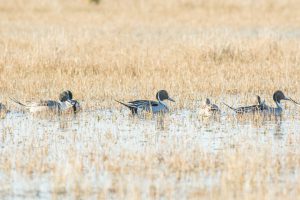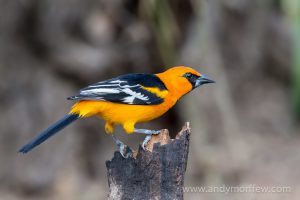Hummingbirds love plants with bright, conical flowers. Their favorites are typically small or shrubby perennials that live through the winter and flower year after year. Slender cone shaped flowers are most attractive, but hummingbirds will also visit more open or flat blooms.
What are the best plants to attract hummingbirds in Texas?
The best flowering plants in Texas for hummingbirds include Coral Honeysuckle, Trumpet Creeper, Turk’s Cap, Cigar Plant, and Flame Acanthus.
For best results at home, plant multiple species that bloom at different times to provide a continuous supply of nectar for hummingbirds from March through late October.
For what types of hummingbirds live in Texas, and which one might show up at your feeder, check out Texas Hummingbird Species and Where to See Them.
Plan Ahead for a Continuous Bloom of Flowers
Hummingbirds begin arriving in Texas in mid-March to set up territories and begin their nesting season. Few flowers are blooming this early, so even the smallest amount of color during March in your garden will easily attract these hungry early arrivals.
Fall migration begins in August, and individuals can be seen as late as mid-November. During the weeks before they fly south, hummingbirds will gorge themselves on nectar to bulk up for their long journey. During August and September you may see unusually high numbers of these birds buzzing around feeders and flowering plants.
So how do you feed hummingbirds from mid-March all the way through the last departure in October or November? Below are suggestions on what to plant based on which months the blooms appear.
| Species | Bloom Months |
| Mexican Buckeye | March – June |
| Coral Honeysuckle | March – June |
| Horsemint | April – June |
| Cigar Plant | May – August |
| Flame Acanthus | June – October |
| Trumpet Creeper | July – September |
| Red Cardinal Flower | July – October |
| Texas Lantana | April – October |
| Autumn Sage | March – November |
| Turk’s Cap | May – November |
Mexican Buckeye
Ungnadia speciosa

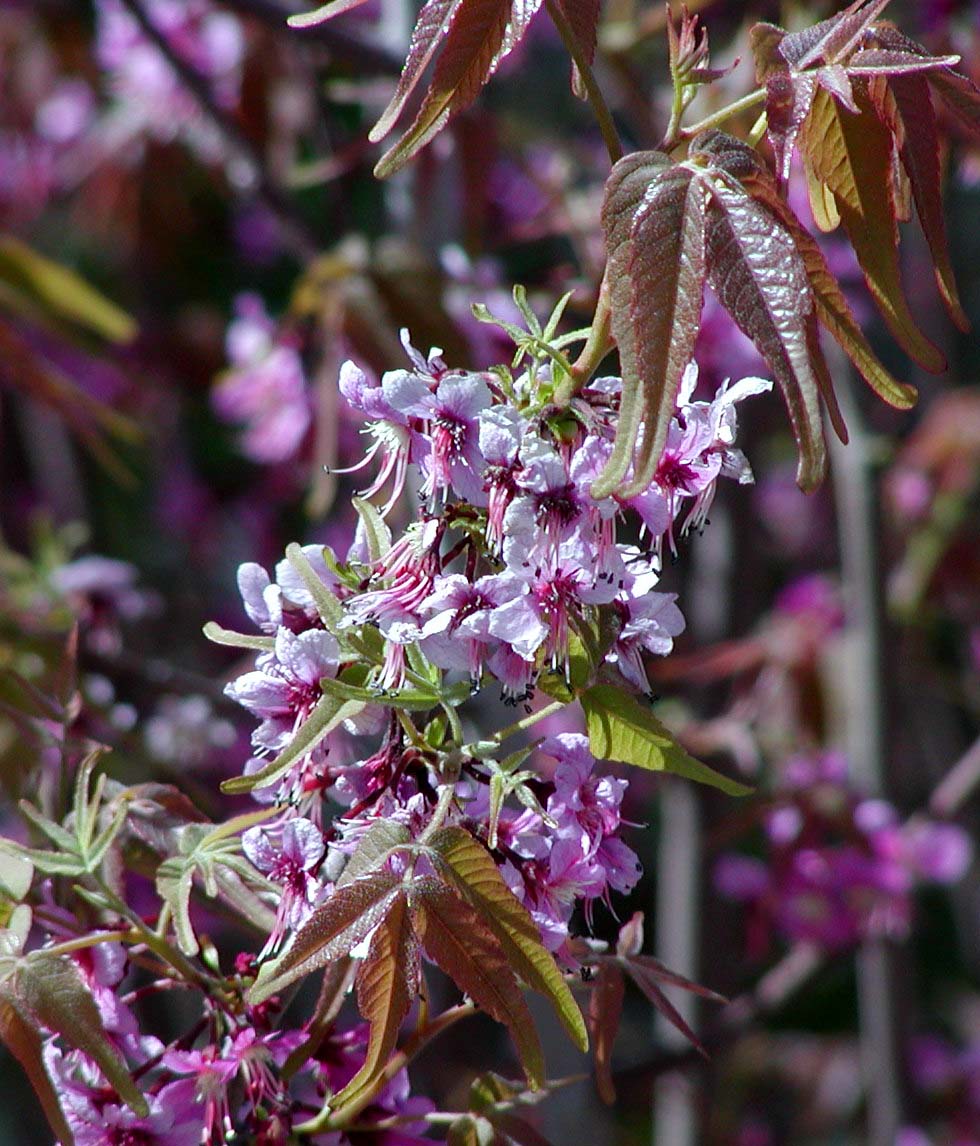
| Bloom Months | March – June |
| Typical Size | 2 – 3 Feet |
| Light Preference | Full Sun |
| Soil Conditions | Dry |
| Water Needs | Low, tolerates low nutrients. |
| Drought Tolerant | Yes |
| Cold Tolerant | Yes |
| Deer Resistant | Yes |
Not to be confused with the unrelated Red Buckeye, the Mexican Buckeye makes the list almost purely because of its early bloom time. It produces beautiful clusters of pink flowers, and although neither the color nor the shape fits a typical hummingbird attractor, hummingbirds will take almost anything they can get during March.
This plant can do well even in the drier and more rocky areas of the state. It is hardy and needs little attention after becoming established as it nears maturity. Growing from a seed to maturity takes about 4 years, although this tree will grow for many years past that.
Coral Honeysuckle
Lonicera sempervirens


| Bloom Months | March – June |
| Typical Size | 3 – 30 Feet |
| Light Preference | Full Sun or Partial Shade |
| Soil Conditions | Rocky, Well Drained |
| Water Needs | Medium. Likes moist soil. |
| Drought Tolerant | No |
| Cold Tolerant | Somewhat. Freezing can cause dieback. |
| Deer Resistant | Yes |
Coral Honeysuckle is a classic hummingbird attractor. The flowers are red, and are tubular/cone shaped, just how the hummers like it. It’s native to east Texas, but can be grown in other areas with proper watering and care.
Like other honeysuckles, this plant grows as a vine and prefers to have support like a tree, shrub, or fence to grow on. Otherwise it will grow as a low sprawling shrub across the ground.
Some plants will begin flowering before March is over, making this a perfect early season bloom.
Horsemint
Monarda citriodora

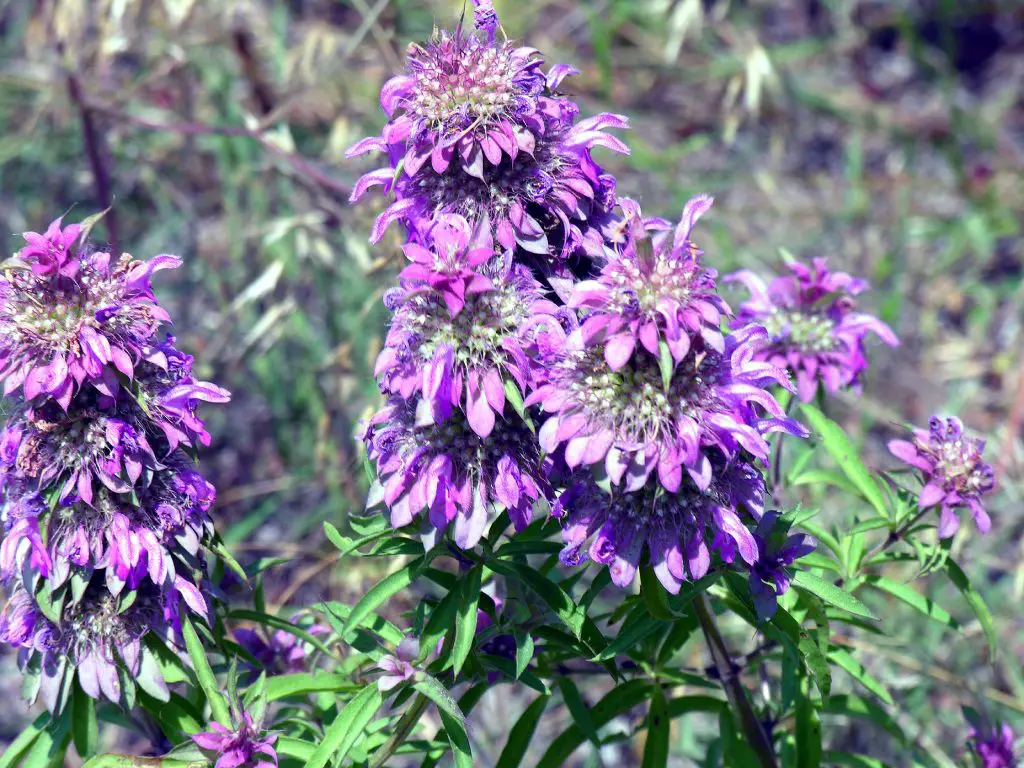
| Bloom Months | April – June |
| Typical Size | 1 – 3 Feet |
| Light Preference | Full Sun |
| Soil Conditions | Dry |
| Water Needs | Low, tolerates low nutrients. |
| Drought Tolerant | Yes |
| Cold Tolerant | No |
| Deer Resistant | Yes |
Horsemint, also called Lemon Beebalm, is a low growing purple flower often associated with prairies and grasslands. It is an effective wildlife attractor and brings in butterflies, bees, and of course hummingbirds.
Although naturally a summer bloomer, this plant has been known to bloom into September when watered consistently. Use it as a low, somewhat dense ground cover to fill in your garden or yard.
Cigar Plant
Cuphea ignea

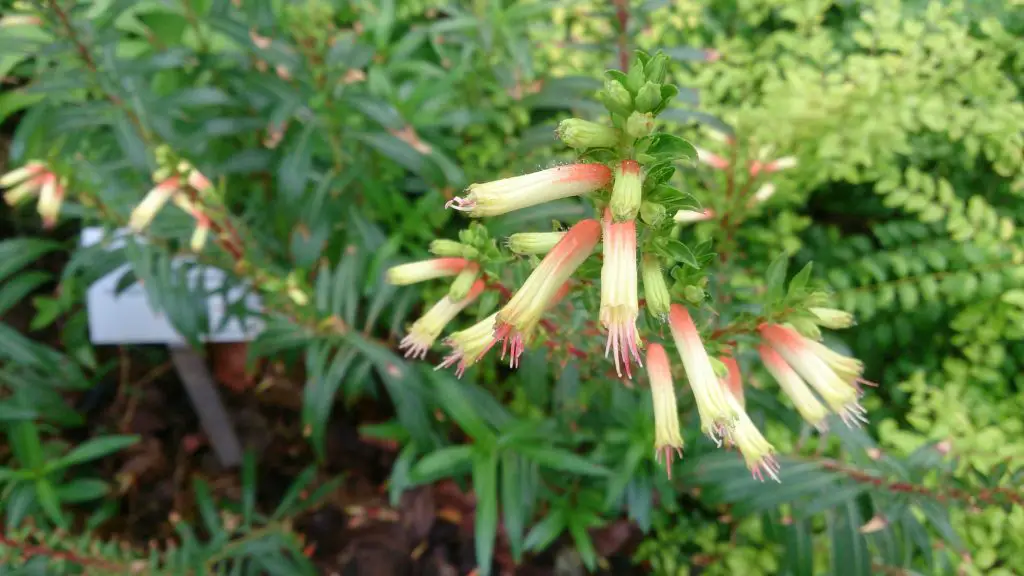
| Bloom Months | May – August |
| Typical Size | 2 – 3 Feet |
| Light Preference | Full Sun |
| Soil Conditions | Dry |
| Water Needs | Low, tolerates low nutrients. |
| Drought Tolerant | No |
| Cold Tolerant | No |
| Deer Resistant | Somewhat |
Also called Firecracker Plant, this tropical plant native to Mexico is great because it’s a strong early and mid-summer bloomer, which can be hard to find in other plants.
It does best in the southern half of the state since frost can easily kill it. In far south Texas in the Rio Grande Valley, it can grow as an evergreen and will bloom even outside of summer.
Trumpet Creeper
Campsis radicans

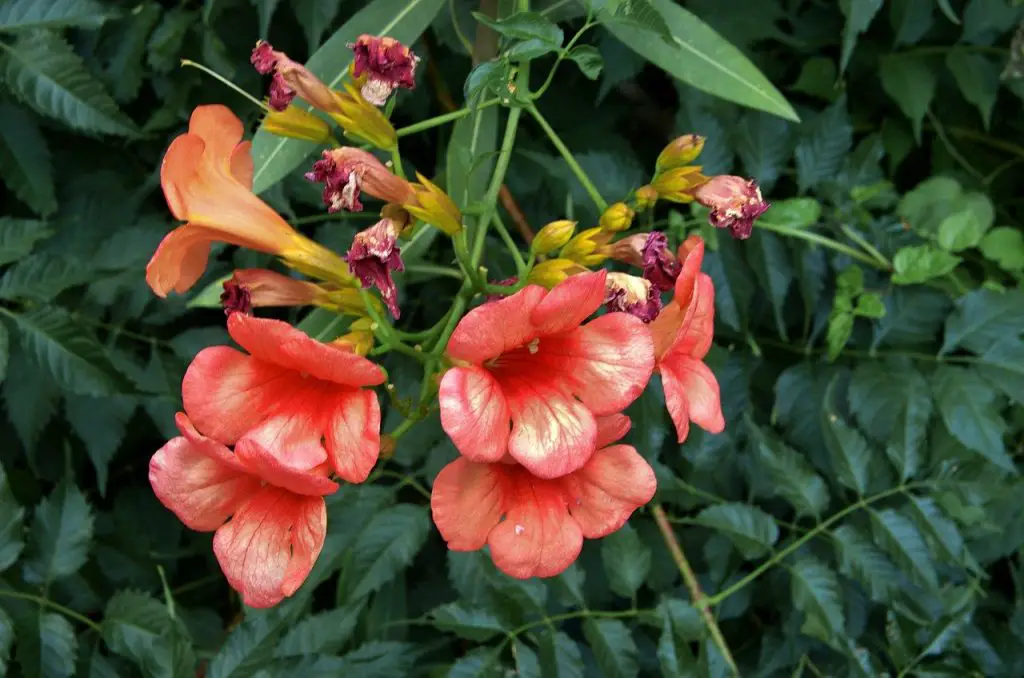
| Bloom Months | July – September |
| Typical Size | 2 – 10+ Feet |
| Light Preference | Full Sun |
| Soil Conditions | Dry |
| Water Needs | Low, tolerates low nutrients. |
| Drought Tolerant | Yes |
| Cold Tolerant | Yes |
| Deer Resistant | Yes |
Trumpet Creeper may be the most famous hummingbird attractor. Not only are its big, showy red flowers a treat to look at, but hummingbirds will swarm them as fall migration begins.
This vine can bloom as early as June, but usually peaks in August and early September. Make sure you give it space to grow, otherwise it can take over and grow on top of other nearby plants.
Trumpet Creeper is good for adding some vertical structure to your yard, since it can grow up high on trees, walls, roofs, or almost anything else, leaving plenty of space on the ground for other plants.
Red Cardinal Flower
Lobelia cardinalis


| Bloom Months | July – October |
| Typical Size | 2 – 3 Feet |
| Light Preference | Partial Shade |
| Soil Conditions | Moist |
| Water Needs | Low, tolerates low nutrients. |
| Drought Tolerant | No |
| Cold Tolerant | No |
| Deer Resistant | No |
Cardinal Flower is a good low-to-the-ground, late season bloomer. It’s a bit more finicky than others on this list in that it needs consistent moisture. In nature it grows along stream beds, swamps, and moist, partly shaded woodland edges.
This plant can be particularly attractive when planted in large clusters. It can also become a target of hungry deer, so those in Central and South Texas should beware.
Flame Acanthus
Anisacanthus quadrifidus

| Bloom Months | June – October |
| Typical Size | 2 – 3 Feet |
| Light Preference | Full Sun |
| Soil Conditions | Dry |
| Water Needs | Low, tolerates low nutrients. |
| Drought Tolerant | Yes |
| Cold Tolerant | Yes |
| Deer Resistant | Yes |
This showy plant is hardy and versatile, able to grow both in drier west and south Texas, and in the wetter regions around Houston and east Texas. It is highly drought tolerant, although it blooms more fully when watered regularly.
Flame Acanthus makes a for a good low growing shrub when planted in the ground, but also does fine in pots.
Texas Lantana
Lantana urticoides


| Bloom Months | April – October |
| Typical Size | 2 – 4 Feet |
| Light Preference | Full Sun |
| Soil Conditions | Dry |
| Water Needs | Low, tolerates low nutrients. |
| Drought Tolerant | Yes |
| Cold Tolerant | Yes |
| Deer Resistant | Yes |
Lantana will bloom on and off throughout an entire growing season, from early spring to middle of fall. This low woody shrub will grow about 3 feet high, but can be 5 or 6 feets across.
The flowers aren’t the typical cone or tubular shape that hummingbirds love, but they still produce nectar and pollen that hummingbirds like. Lantana is also an excellent butterfly attractor.
Include Lantana in your mix of plants to help provide some mid-summer color, when other plants are in between bloom times. It does best in full sun, but will also grow in partial shade.
Autumn Sage
Salvia greggii

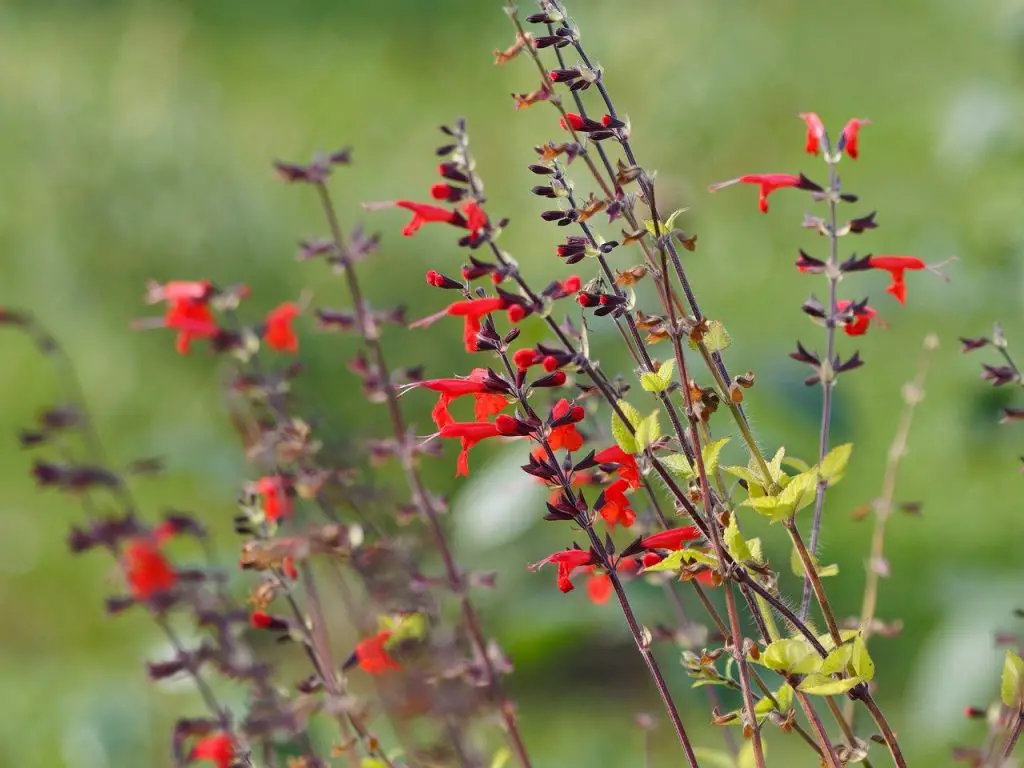
| Bloom Months | March – November |
| Typical Size | 2 – 3 Feet |
| Light Preference | Full Sun |
| Soil Conditions | Well Drained |
| Water Needs | Low, tolerates low nutrients. |
| Drought Tolerant | Yes |
| Cold Tolerant | Yes |
| Deer Resistant | Yes |
Autumn Sage has one of the longest bloom ranges on this list. Some individual plants will bloom heavily in the spring, others in the fall. If they bloom in the fall, this plant is a good late season option for hummers on their way south for the winter.
This plant does especially well in the more rocky, well-drained soils of central, south, and west Texas. It can also tolerate low nutrient soils, so fertilizer won’t be needed once the plant is established.
Turk’s Cap
Malvaviscus arboreus

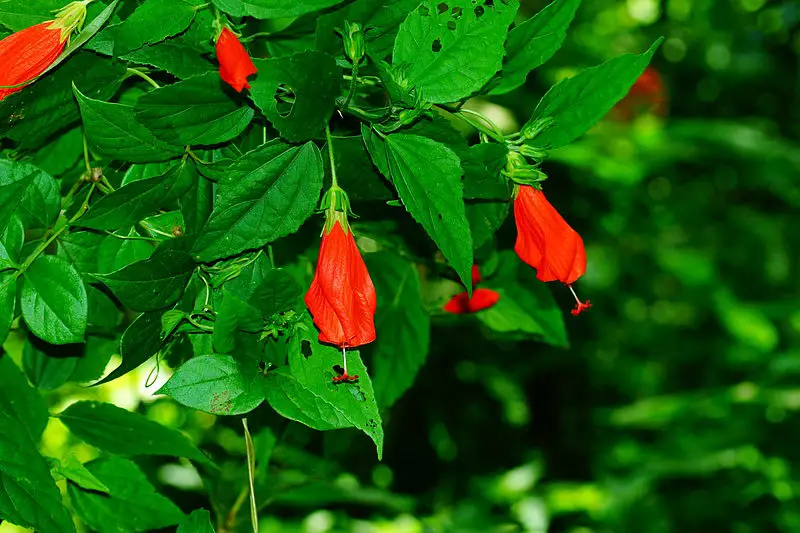
| Bloom Months | May – November |
| Typical Size | 2 – 3 Feet |
| Light Preference | Full Sun |
| Soil Conditions | Dry |
| Water Needs | Low, tolerates low nutrients. |
| Drought Tolerant | Yes |
| Cold Tolerant | Yes |
| Deer Resistant | Yes |
Also called Wax Mallow, this is another excellent late season bloomer. It can bloom as early as May, but typically blooms most heavily from August to October.
Turk’s Cap can tolerate a wide range of light and moisture conditions, but does best in partial shade with intermittent watering.
This flower is a good option for planting around the base of tall trees that will provide the partial shade.
Plant multiple large clusters and you’ll have hummingbirds feeding on them throughout the day from late August until late October.


